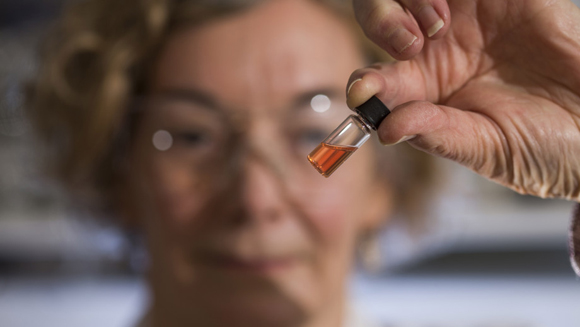Scientists Identify the World’s Oldest Biological Colours
A team of international scientists including researchers from the University of Liège, Florida State University and the Australian National University, in collaboration with a colleague based in Japan have discovered the oldest colours preserved in the fossil record. An analysis of the remains of microscopic, 1.1 billion-year-old cyanobacteria suggest that life back in the Proterozoic was “in the pink”. Pink coloured pigments have been extracted from ancient marine shales that form part of the Taoudeni Basin of Mauritania (north-western Africa).
When Held Up in the Light the Pink Colouration can be Seen
Picture credit: Australian National University
Pink in the Fossil Record
One of the authors of the scientific paper, published in the “Proceedings of the National Academy of Sciences of the USA”, Dr Nur Gueneli (Australian National University), explained that the pigments taken from the marine black shales were more than six hundred million years older than previous pigment discoveries.
Dr Gueneli commented:
“The bright pink pigments are the molecular fossils of chlorophyll that were produced by ancient photosynthetic organisms inhabiting an ancient ocean that has long since vanished.”
Samples of the shales laid down during the Stenian, the last geological period of the Mesoproterozoic Era, were ground into fine powder before the ancient molecules of long extinct cyanobacteria could be extracted and analysed. The fossils reveal a range of colours from a blood red to a deep purple in their concentrated form, but when diluted, it is the colour pink that dominates.
Dr Gueneli, who undertook this research whilst studying for a PhD added:
“The precise analysis of the ancient pigments confirmed that tiny cyanobacteria dominated the base of the food chain in the oceans a billion years ago, which helps to explain why animals did not exist at the time.”
A Lack of Things for Higher Organisms to Eat
Complicated animal life was not able to evolve, according to one hypothesis, as it was restrained by the lack of food in the ocean. In essence, life on Earth could not pick up the evolutionary pace as food webs were constrained by the amount of primary producers in the ecosystem.
Through the team’s discovery of molecular fossils of the photopigment chlorophyll in 1.1-billion-year-old marine sedimentary rocks, they were able to quantify the abundance of different organisms that uses the sun’s energy to produce food (phototrophs). Nitrogen isotopic values of the fossil pigments revealed that the Pan-African Ocean was dominated by cyanobacteria, while larger planktonic algae were very scarce. These findings support the hypothesis that small cells at the base of the food chain limited the flow of energy to higher trophic levels, potentially retarding the emergence of large and complex life.
Associate Professor Jochen Brooks, of the Research School of Earth Sciences (Australian National University), one of the authors of the scientific paper, stated that the emergence of more complex life forms was likely to have been restricted by the limited supply of larger food particles, such as algae.
Associate Professor Brooks explained:
“Algae, although still microscopic, are a thousand times larger in volume than cyanobacteria, and are a much richer food source. The cyanobacterial oceans started to vanish about 650 million years ago, when algae began to rapidly spread to provide the burst of energy needed for the evolution of complex ecosystems, where large animals, including humans, could thrive on Earth.”
Visit the Everything Dinosaur website: Everything Dinosaur.







Leave A Comment